Lena expedition 2002
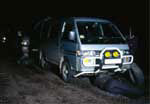 After an 18-hour drive in two Japanese mini buses and an Uasik over highways and gravel roads, the ice of the river Lena lays behind us, like two flat tyres and a problem with the automatic gearbox, too. We are in the taiga, in the base camp of the Peshera Botovskaya. With a passage length of presently 57 kilometres it is Russia's longest cave.
After an 18-hour drive in two Japanese mini buses and an Uasik over highways and gravel roads, the ice of the river Lena lays behind us, like two flat tyres and a problem with the automatic gearbox, too. We are in the taiga, in the base camp of the Peshera Botovskaya. With a passage length of presently 57 kilometres it is Russia's longest cave.
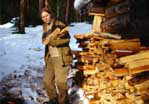 Our drivers immediately start the return trip and we head for the forest with saw and axe in order to chop wood the next two days. The Banya, the living and sleeping hut, wants to be heated. The cave entry itself is 5 kilometres uphill, and here as well we have to chop wood first. But there is always time for a tea, and the carbide lamps need water, too!
Our drivers immediately start the return trip and we head for the forest with saw and axe in order to chop wood the next two days. The Banya, the living and sleeping hut, wants to be heated. The cave entry itself is 5 kilometres uphill, and here as well we have to chop wood first. But there is always time for a tea, and the carbide lamps need water, too!
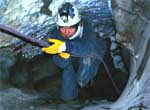 Our group looks like a dispersed partisan unit due to our old army combinations. But who can see us here? So we disappear into the dark. At the entry we come across wonderfully beautiful ice crystals, passages with perfect key hole profiles, crystal clear ice stalagmites, and at each junction you see a badge. These serve as orientation in the cave and are urgently necessary for almost 6000 cross-ways. "without light and a map you are broken-down instantly", Sascha says and is probably right.
Our group looks like a dispersed partisan unit due to our old army combinations. But who can see us here? So we disappear into the dark. At the entry we come across wonderfully beautiful ice crystals, passages with perfect key hole profiles, crystal clear ice stalagmites, and at each junction you see a badge. These serve as orientation in the cave and are urgently necessary for almost 6000 cross-ways. "without light and a map you are broken-down instantly", Sascha says and is probably right.
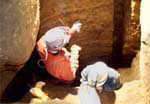 After almost a week of prearrangement and familiarisation we finally kick off. Some work at a digging with a depth of about 2 metres, take samples, and mark the profile. Others exchange the old paper badges with aluminium badges, search for new passages, take water samples, and the rest films the action.
After almost a week of prearrangement and familiarisation we finally kick off. Some work at a digging with a depth of about 2 metres, take samples, and mark the profile. Others exchange the old paper badges with aluminium badges, search for new passages, take water samples, and the rest films the action.
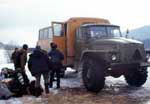 But supposedly we have heated our Banya too often. For the first time in decades it is raining in March and almost every day the thermometer shows more than 0° Celsius. During our hike over the river Lena towards Alexej, a bear hunter, we see the tragedy. The ice of the Lena is thawing, the lanes are partly 50 cm deep.
But supposedly we have heated our Banya too often. For the first time in decades it is raining in March and almost every day the thermometer shows more than 0° Celsius. During our hike over the river Lena towards Alexej, a bear hunter, we see the tragedy. The ice of the Lena is thawing, the lanes are partly 50 cm deep.
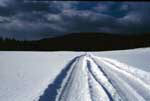 A few days later it is certain. Out mini buses are trapped 90 kilometres south, only the Uasik has been towed by a Ural. Some try the return trip in the Uasik, 10 hours later they have managed 80 kilometres of the way. The rest is waiting at the riverbank of the Lena, is playing ice hockey and tries to hitchhike. Every 4 hours a car drives past. We are lucky, because a Ural gives us a lift and slowly rocks us towards Shigallovo. Just before our destination, the Uasik is stuck for good, only with the help of the Ural we can drive on. After 25 hours we are in Irkutsk.
A few days later it is certain. Out mini buses are trapped 90 kilometres south, only the Uasik has been towed by a Ural. Some try the return trip in the Uasik, 10 hours later they have managed 80 kilometres of the way. The rest is waiting at the riverbank of the Lena, is playing ice hockey and tries to hitchhike. Every 4 hours a car drives past. We are lucky, because a Ural gives us a lift and slowly rocks us towards Shigallovo. Just before our destination, the Uasik is stuck for good, only with the help of the Ural we can drive on. After 25 hours we are in Irkutsk.

